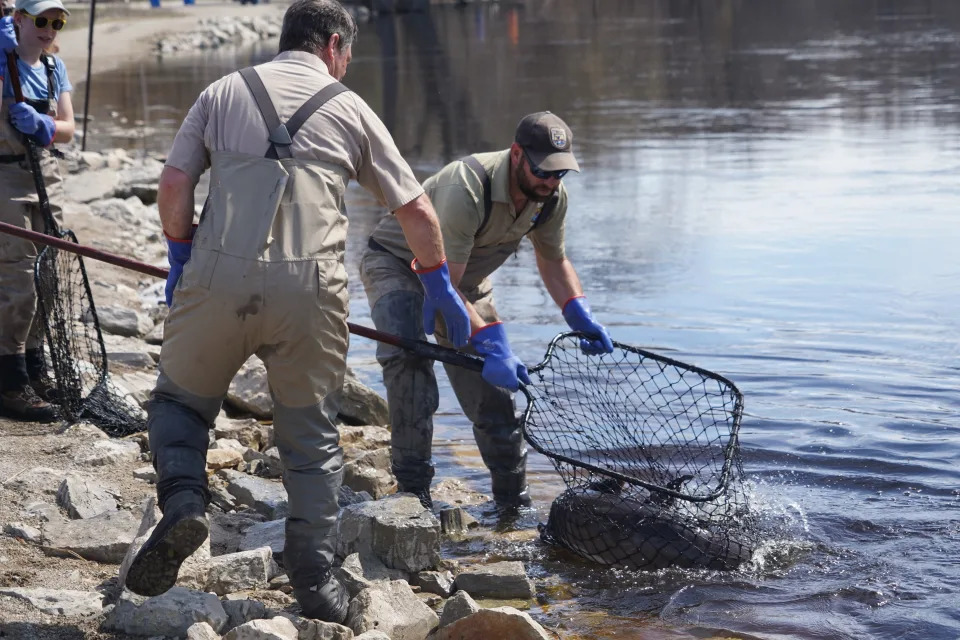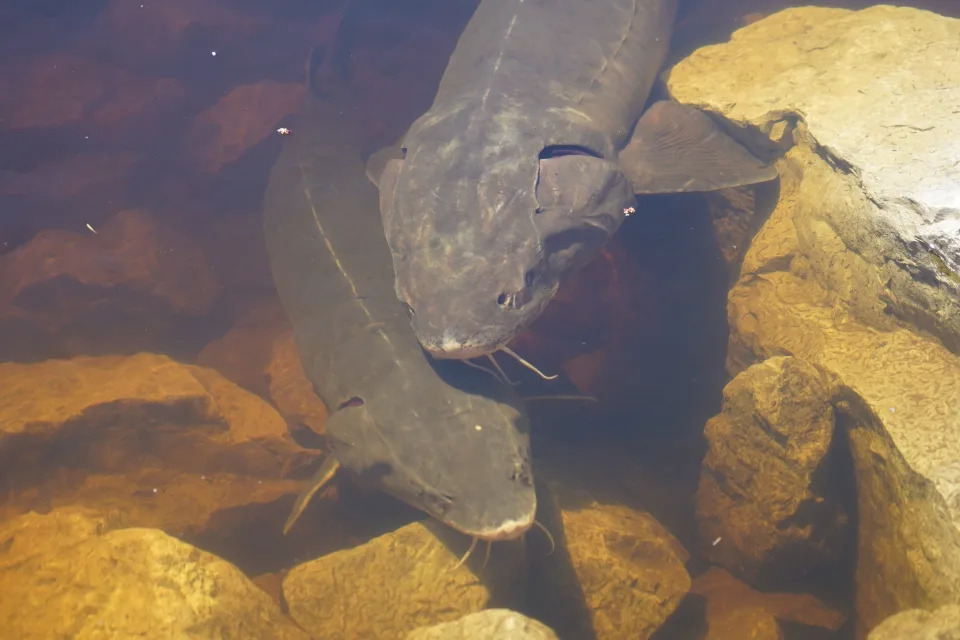Sturgeon could SHOULD be listed as endangered species, but Wisconsin’s congressional reps want an exemption. Here’s why.
A bipartisan group of Wisconsin's congressional delegation has urged the U.S. Fish and Wildlife Service to exempt lake sturgeon in the state from any potential listing under the federal Endangered Species Act.
The agency is conducting a status review of lake sturgeon in the U.S. to determine if listing is warranted; it is scheduled to release its findings by June 30, 2024.
A federal listing under the ESA could prohibit angling for or spearing the fish in Wisconsin. The state hosts annual hook-and-line and spearing seasons for lake sturgeon managed by the Department of Natural Resources.
It a statement issued Dec. 7 the six U.S. representatives and two senators highlighted the robust sturgeon population in Wisconsin, the strong state-based management program as well as the cultural, ecological and economical values of the fish.
"Nowhere in the world will you find such a unique cultural connection and staunch dedication to the preservation of sturgeon population levels than in Wisconsin," the group wrote. "In fact, due to such careful management, populations in the state thrive and allow for a sustainable spear harvest season on the Winnebago System every winter. We are concerned that a potential listing of the species under the Endangered Species Act could curtail this successful, science-based management model as well as threaten a cherished and unique Wisconsin tradition."
Republican Rep. Mike Gallagher, whose district includes part of the Winnebago System, led the effort on the statement. It was also signed by Republican Reps. Scott Fitzgerald, Glenn Grothman,, Bryan Steil, Tom Tiffany and Derrick Van Orden as well as Democratic Sen. Tammy Baldwin and Republican Sen. Ron Johnson.
In 2018 the USFWS received a petition from the Center for Biological Diversity requesting the agency list the lake sturgeon range-wide or as several distinct population segments.
The next year the agency concluded the petition presented "substantial scientific or commercial information indicating listing may be warranted" and initiated a status review process, according to a statement from Melissa Clark, USFWS public affairs specialist.
The USFWS is actively engaged in the review and is gathering and referencing the "best scientific and commercial data available, which includes information regarding States’ management practices for lake sturgeon throughout the range of the species," Clark said.
Lake sturgeon are one of the oldest fish species in North America and are native to at least two dozen states in the central, southern and eastern U.S. according to the USFWS. In Wisconsin they are found in Lakes Michigan and Superior as well as the Wisconsin, Chippewa and Flambeau, Wolf and Fox rivers, among others.
The Wisconsin congressional delegation said the importance of the prehistoric fish is rooted in the Menominee Tribe’s strong cultural ties to the lake sturgeon. The tribe includes sturgeon in its creation story and also relied on the fish as a food source.
The species declined over the last century in many parts of its historical range due to pollution, overfishing and loss of access to spawning habitat.
But several populations are exceptions, including the Detroit River and Lake St. Clair in Lake Huron in Michigan, the Rainy River and Lake of the Woods in Minnesota and the Winnebago System in Wisconsin, said Ron Bruch, retired DNR fisheries director and former sturgeon biologist.
After a period of closed seasons in the early 20th Century due to concerns of overharvest, the sturgeon population in the Winnebago System (lakes Butte des Morts, Poygan, Winnebago and Winneconne and the Fox and Wolf rivers) has grown to become one of the largest in the world, Bruch said.
More: Outdoors calendar
The DNR establishes a sturgeon population estimate each year using a mark and recapture process. In 2022 the population was estimated at 12,304 adult females and 24,061 adult males, as well as an undetermined number of juvenile fish, according to the DNR sturgeon stock assessment report.
And strict regulations limit the harvest of sturgeon to ensure the health of the population, Bruch said.
"The sturgeon population in the Winnebago System is as large now as any time after settlement times," Bruch said. "It's strong and naturally-reproducing. In no way is it threatened or endangered."
The two-week sturgeon spearing season is responsible for an estimated $3.5 million economic impact and sturgeon conservation is a major part in the over $200 million annual impact fishing brings to the Winnebago System, according to the Wisconsin congressional members.
In 2023 the DNR sold 13,219 sturgeon spearing licenses and 1,405 sturgeon were registered over the 16-day spearing season in February on the Winnebago System.
A hook-and-line sturgeon season is held in fall on many major river systems in the state. Anglers are allowed to keep one fish per year but most fishing is catch-and-release. The statewide harvest of sturgeon during the fall season has averaged 33 fish over the last 15 years, according to the DNR. The hook-and-line season is not held on the Winnebago System.
Money raised from the sale of sturgeon spearing and fishing licenses is used to fund Wisconsin sturgeon management programs.
A representative for the Center for Biological Diversity, the organization that asked for the review, said it's most likely the most imperiled populations – Lake Superior, Missouri River, Ohio River, Arkansan-White River, and lower Mississippi, in their view – would get listed.
"The loss of lake sturgeon has been analogous to the slaughter of the buffalo," said Jeff Miller, senior conservation advocate for CBD. "Now there are only nine populations in entire U.S. with more than 1,000 adult fish."
However, Miller said his group doesn't oppose a DNR-managed harvest season in the Winnebago System.
"We don’t see any problem with the short spear-fishing fishery in the Lake Winnebago System and the Upriver Lakes," Miller said. "It hosts a large population of lake sturgeon, and there are strict regulations and quotas."
But the CBD would like to see added protections for sturgeon in other parts of Wisconsin, including lakes Michigan and Superior and their tributaries as well as the Chippewa River.
If lake sturgeon were listed under the ESA, the U.S. Fish and Wildlife Service could still allow state fisheries to hold harvest seasons with a fish management plan that is consistent with recovery.
The Wisconsin congressional members asked the Service to to take into "strong consideration the conservation success story of the species in Wisconsin."
"Instead of imposing a nationwide, one-size-fits-all listing that could curtail the state’s management plan and threaten a long-cherished tradition, we ask that Wisconsin lake sturgeon be exempt from any potential ESA listing," they wrote. "Furthermore, we encourage the Service to engage with the Wisconsin DNR, local communities, and other relevant stakeholders to help expand this model to other states and ensure the continued existence of lake sturgeon for generations to come."
The statement by members of Wisconsin's congressional delegation follows an October letter with a similar message signed by 29 members of the state legislature.
A public comment period will be held after the Service issues its findings in June 2024.
This article originally appeared on Milwaukee Journal Sentinel: Lawmakers want Wisconsin sturgeon exempt from endangered species list












